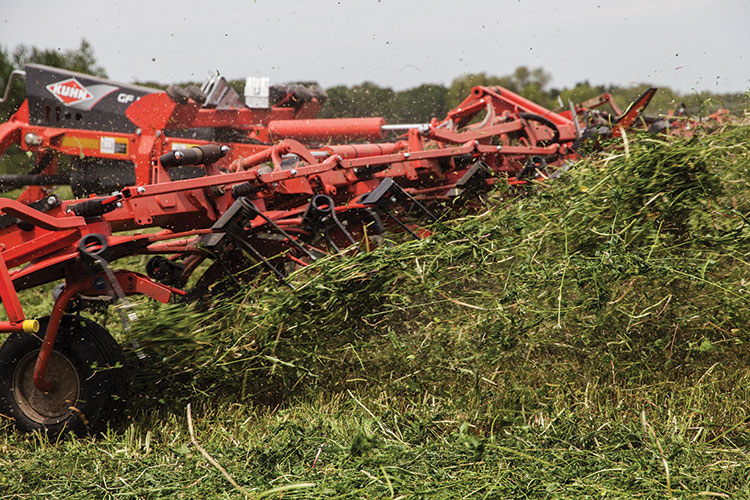 Tedders have become a popular means to speed hay drying. Size tedders based on the width of your mower.
Tedders have become a popular means to speed hay drying. Size tedders based on the width of your mower.Two questions that I often hear my hay farmer customers ponder are:
- Do we really need to spend the extra money on a mower-conditioner, or can we get by with the straight disc mower that we have used for decades?
- If we don’t buy the conditioner, is a tedder a good investment, and which type should we consider?
The first question is one that I get all of the time, and the second is usually a result of the decision made on the mower type. To me, the first question is easier to answer if you narrow down the end goal of your haying operation. If you cut all of your own hay for use on your farm and are not tied down with numerous other summer farm activities, the nonconditioning mowers will work fine.
If you custom hay for other farms or consider yourself a commercial-sized operation, then I personally think
that you can’t afford not to have a mower-conditioner. Basically, if time and/or acreage are constraining, then the few hours saved in dry down time for each cut will pay big dividends.
On our farm, and those of some of my customers, we have done some very nonscientific comparisons; most of the time it was unintentional. What we have seen when putting up dry bermudagrass hay is that if the temperature is hot and conditions are trending dry, there is not much difference in dry down time between the conditioned and nonconditioned hay. This is especially true if a tedder is used on both.
If the hay is thick and conditions are wet and humid, then there can be as much as half a day difference in what section of the field is ready to bale. If you get 30-plus inches of rain annually and you put up several thousand round bales, then I think a conditioner is a wise investment. For those in drier areas, you can maybe save that extra money from not purchasing a conditioning mower and use that on a wet-year insurance policy I call the tedder, or “fluffer” as it is sometimes referred to in the South.
Once you’ve made your mower selection and have that problem settled, it leads us to the second question.
Hay tedders have been historically limited to the higher rainfall states, but are now creeping into the drier climate hay markets as well. The current model tedders have come a long way from the four-rotor, manual-fold versions of the 1980s and 1990s. These days, models have up to 18 rotors with transport wheels and can be raised while still working. On our farm, we used to have three tedders, three tractors, and three people dedicated everyday to nothing but fluffing hay. Now, one person with one tractor and tedder can cover the same acreage in half of the time. This drastically changed the cost of speeding the hay drying process.
Tedders are also becoming popular in parts of the country that harvest a lot of alfalfa acres. When used on alfalfa, it’s important not to operate after the hay gets too dry. Doing so may result in significant leaf loss and drastically lower the quality and value of the end product.
New tedder models have several different adjustments for setting how aggressive they are when spreading out the hay. This makes it feasible to ted straight alfalfa and reduce bleaching in heavy first cuttings. It also makes your hay more valuable when selling it, especially in the horse market where looks and visual appeal are everything.
The only real question is what size tedder you need, and that usually depends on what size mowers you run. Depending on mower width, you can usually find a tedder that matches two, three, four, or even five mower swaths.
I’m a big fan of the tedder regardless of whether you have a mower with a conditioner or without. Our two original questions really aren’t that hard to answer, but much depends on the size of your operation and what your typical weather conditions present during the hay harvest season. Happy haying!
This article appeared in the August/September 2018 issue of Hay & Forage Grower on page 26.
Not a subscriber? Click to get the print magazine

